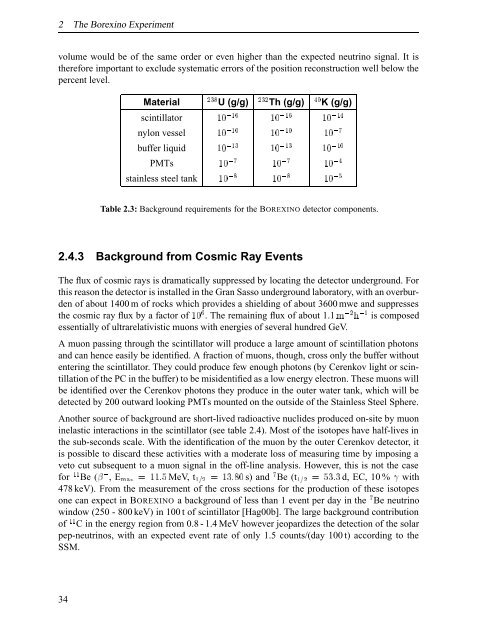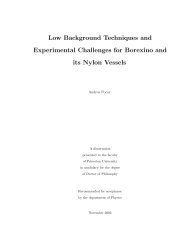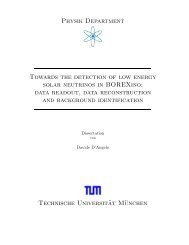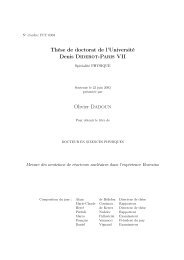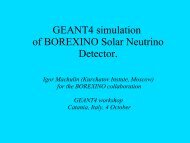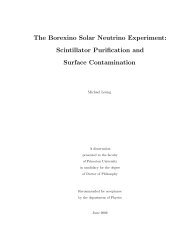Development of a Liquid Scintillator and of Data ... - Borexino - Infn
Development of a Liquid Scintillator and of Data ... - Borexino - Infn
Development of a Liquid Scintillator and of Data ... - Borexino - Infn
You also want an ePaper? Increase the reach of your titles
YUMPU automatically turns print PDFs into web optimized ePapers that Google loves.
2 The <strong>Borexino</strong> Experiment<br />
volume would be <strong>of</strong> the same order or even higher than the expected neutrino signal. It is<br />
therefore important to exclude systematic errors <strong>of</strong> the position reconstruction well below the<br />
percent level.<br />
Material U (g/g) Th (g/g) K (g/g)<br />
scintillator <br />
nylon vessel <br />
buffer liquid<br />
PMTs <br />
stainless steel tank <br />
Table 2.3: Background requirements for the BOREXINO detector components.<br />
2.4.3 Background from Cosmic Ray Events<br />
The flux <strong>of</strong> cosmic rays is dramatically suppressed by locating the detector underground. For<br />
this reason the detector is installed in the Gran Sasso underground laboratory, with an overburden<br />
<strong>of</strong> about 1400 m <strong>of</strong> rocks which provides a shielding <strong>of</strong> about 3600 mwe <strong>and</strong> suppresses<br />
the cosmic ray flux by a factor <strong>of</strong> . The remaining flux <strong>of</strong> about 1.1 Ñ is composed<br />
essentially <strong>of</strong> ultrarelativistic muons with energies <strong>of</strong> several hundred GeV.<br />
A muon passing through the scintillator will produce a large amount <strong>of</strong> scintillation photons<br />
<strong>and</strong> can hence easily be identified. A fraction <strong>of</strong> muons, though, cross only the buffer without<br />
entering the scintillator. They could produce few enough photons (by Cerenkov light or scintillation<br />
<strong>of</strong> the PC in the buffer) to be misidentified as a low energy electron. These muons will<br />
be identified over the Cerenkov photons they produce in the outer water tank, which will be<br />
detected by 200 outward looking PMTs mounted on the outside <strong>of</strong> the Stainless Steel Sphere.<br />
Another source <strong>of</strong> background are short-lived radioactive nuclides produced on-site by muon<br />
inelastic interactions in the scintillator (see table 2.4). Most <strong>of</strong> the isotopes have half-lives in<br />
the sub-seconds scale. With the identification <strong>of</strong> the muon by the outer Cerenkov detector, it<br />
is possible to discard these activities with a moderate loss <strong>of</strong> measuring time by imposing a<br />
veto cut subsequent to a muon signal in the <strong>of</strong>f-line analysis. However, this is not the case<br />
for Be (¬ ,EÑÜ MeV, t s) <strong>and</strong> Be (t d, EC, 10 % with<br />
478 keV). From the measurement <strong>of</strong> the cross sections for the production <strong>of</strong> these isotopes<br />
one can expect in BOREXINO a background <strong>of</strong> less than 1 event per day in the Be neutrino<br />
window (250 - 800 keV) in 100 t <strong>of</strong> scintillator [Hag00b]. The large background contribution<br />
<strong>of</strong> C in the energy region from 0.8 - 1.4 MeV however jeopardizes the detection <strong>of</strong> the solar<br />
pep-neutrinos, with an expected event rate <strong>of</strong> only 1.5 counts/(day 100 t) according to the<br />
SSM.<br />
34


